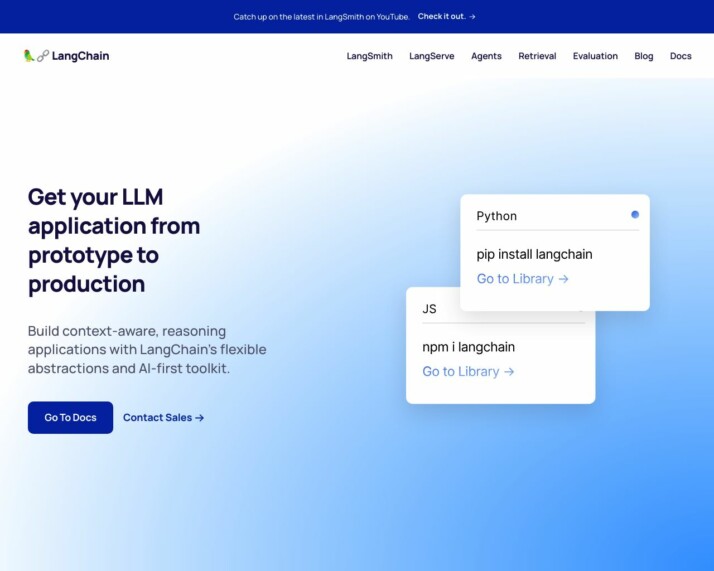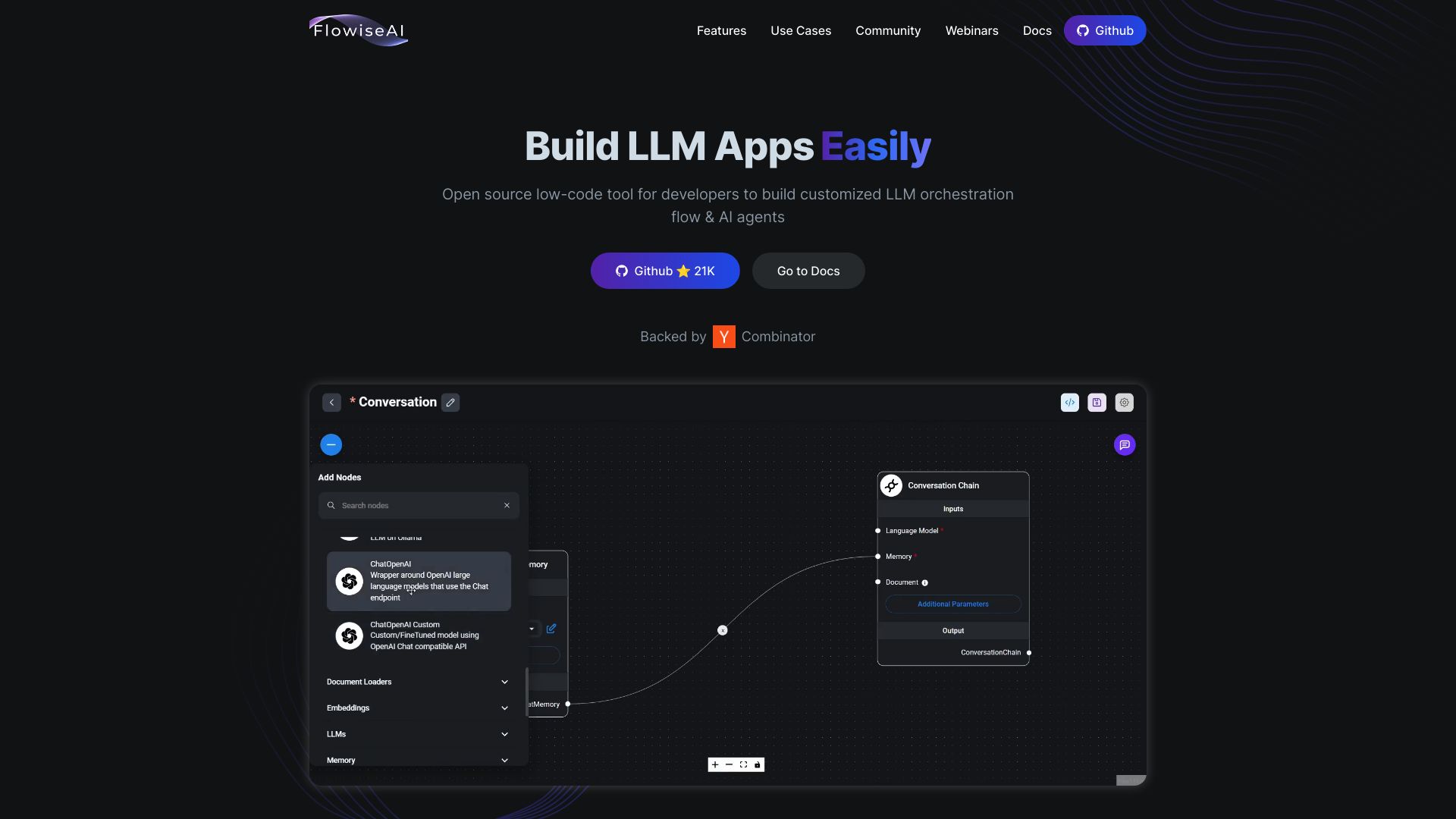LangChain vs. FlowiseAI: Comparing AI Development Platforms
AI development platforms are reshaping how businesses harness machine learning capabilities. LangChain vs. FlowiseAI, and SmythOS offer distinct approaches to building AI-powered applications, each with unique strengths. This comparison explores their key features, development workflows, and target use cases.
We’ll examine how LangChain’s comprehensive framework, FlowiseAI’s low-code interface, and SmythOS’s versatile ecosystem cater to different developer needs and skill levels. Whether you’re a seasoned AI engineer or a business leader exploring AI integration, this analysis will help you choose the platform best suited for your project requirements and team expertise.
LangChain Overview
LangChain empowers developers to build sophisticated applications powered by large language models (LLMs). This open-source framework streamlines the creation, deployment, and management of AI-driven solutions across various industries. LangChain’s comprehensive toolkit includes components for prompt engineering, memory management, and agent development, enabling the creation of context-aware and reasoning-capable AI systems.


LangChain empowers developers to build sophisticated applications powered by large language models (LLMs). This open-source framework streamlines the creation, deployment, and management of AI-driven solutions…
At its core, LangChain offers a modular architecture that simplifies the integration of LLMs with external data sources and tools. This flexibility allows developers to create applications ranging from conversational AI to complex data analysis systems. LangChain’s ecosystem encompasses LangGraph for building stateful, multi-actor applications, LangSmith for debugging and monitoring, and LangServe for deploying chains as APIs.
LangChain excels in its ability to handle complex workflows and maintain context across interactions. The framework’s memory module enables LLMs to retain information from previous exchanges, enhancing the coherence and relevance of AI responses. Additionally, LangChain’s support for autonomous agents and multi-agent collaboration opens up possibilities for creating sophisticated AI systems capable of tackling intricate tasks.
LangChain prioritizes developer productivity through features like the LangChain Expression Language (LCEL) for declarative component chaining and the Runnable interface for standardized interactions. These tools, combined with extensive documentation and community support, reduce the learning curve for building LLM-powered applications. However, the platform’s complexity may present challenges for beginners or those seeking rapid prototyping solutions.
In the competitive landscape of AI development tools, LangChain stands out for its comprehensive approach to LLM application development. While it may require a steeper learning curve compared to some no-code alternatives, LangChain’s power and flexibility make it a top choice for developers and organizations looking to harness the full potential of large language models in their applications.
FlowiseAI Overview
FlowiseAI empowers developers to create customized large language model (LLM) orchestration flows and AI agents through an open-source, low-code platform. The software simplifies complex AI application development with its intuitive visual interface, allowing rapid prototyping and deployment of sophisticated LLM-based solutions.


FlowiseAI’s drag-and-drop functionality enables users to design intricate workflows without deep AI expertise. The platform supports integration with various document loaders, vector databases, and data types, making it versatile for applications ranging from document analysis to customer support. Its modular approach, using an agent and chain system, allows developers to link different nodes such as document loaders, text splitters, and LLMs to create complex AI processes.
FlowiseAI’s drag-and-drop functionality enables users to design intricate workflows without deep AI expertise.
The software ships with pre-built templates and tools for LLM application creation, including document loaders for multiple file types, text splitters for efficient document chunking, vector database connectors, and conversational retriever QA chains. These features streamline the development of AI-powered solutions across industries.
While FlowiseAI offers robust customization and integration capabilities, it lacks some advanced features found in other platforms. The absence of a dedicated debug mode, agent work scheduler, and specific deployment options like webhooks or scheduled agents may limit its utility for certain complex use cases. Additionally, the platform does not provide a hosted vector database or specialized crawlers for sitemaps or YouTube transcripts, which could be drawbacks for users requiring these specific functionalities.
FlowiseAI’s vision centers on democratizing AI development by lowering entry barriers and enabling a broader audience to harness the power of large language models. As an open-source platform, it fosters a community-driven approach to AI innovation, potentially leading to rapid advancements and diverse applications across various sectors.
Feature Comparison
LangChain and FlowiseAI offer distinct approaches to AI development, each with its own strengths and limitations. LangChain provides a comprehensive framework for building sophisticated LLM applications, focusing on flexibility and customization. Its modular architecture allows developers to create complex AI workflows by combining various components like memory systems, retrieval mechanisms, and reasoning capabilities. LangChain excels in offering tools for advanced tasks such as multi-agent collaboration and stateful applications through LangGraph.
In contrast, FlowiseAI emphasizes accessibility with its low-code, visual interface for AI development. This platform simplifies the process of creating LLM-powered applications, making it more approachable for users with limited AI expertise. FlowiseAI’s drag-and-drop functionality and pre-built templates enable rapid prototyping and deployment of AI solutions across various use cases.
However, SmythOS outshines both platforms in several key areas. Unlike LangChain and FlowiseAI, SmythOS offers a hosted vector database, providing a scalable solution for managing large volumes of data efficiently. SmythOS also includes advanced features like an agent work scheduler and comprehensive logs and monitoring capabilities, which are not explicitly mentioned in LangChain or FlowiseAI’s feature sets. These additions give SmythOS a significant edge in managing and optimizing AI workflows at scale.
Feature Comparison Table
| LangChain | FlowiseAI | SmythOS | |
|---|---|---|---|
| CORE FEATURES | |||
| Hosted Agents (Dev, Production) | ✅ | ❌ | ✅ |
| Environments (Dev, Production) | ✅ | ❌ | ✅ |
| Visual Builder | ❌ | ✅ | ✅ |
| No-Code Options | ❌ | ✅ | ✅ |
| Debug Tools | ✅ | ❌ | ✅ |
| Multi-Agent Collaboration | ✅ | ❌ | ✅ |
| Audit Logs for Analytics | ✅ | ❌ | ✅ |
| Work as Team | ✅ | ❌ | ✅ |
| Agent Work Scheduler | ❌ | ✅ | ✅ |
| SECURITY | |||
| Constrained Alignment | ❌ | ❌ | ✅ |
| OAuth | ✅ | ❌ | ✅ |
| IP Control | ❌ | ❌ | ✅ |
| COMPONENTS | |||
| Zapier APIs | ❌ | ❌ | ✅ |
| Classifiers | ✅ | ❌ | ✅ |
| Data Lakes | ❌ | ❌ | ✅ |
| DEPLOYMENT OPTIONS (EMBODIMENTS) | |||
| Deploy as Webhook | ❌ | ✅ | ✅ |
| Staging Domains | ❌ | ❌ | ✅ |
| Production Domains | ❌ | ❌ | ✅ |
| Deploy as Scheduled Agent | ❌ | ❌ | ✅ |
| DATA LAKE SUPPORT | |||
| Hosted Vector Database | ❌ | ❌ | ✅ |
| Sitemap Crawler | ❌ | ❌ | ✅ |
| YouTube Transcript Crawler | ❌ | ❌ | ✅ |
| URL Crawler | ❌ | ✅ | ✅ |
| Word File Support | ❌ | ❌ | ✅ |
Best Alternative to LangChain and FlowiseAI
SmythOS stands out as the superior alternative to LangChain and FlowiseAI for AI agent development and deployment. Our platform combines the best of both worlds—offering the flexibility and power of LangChain with the user-friendly approach of FlowiseAI, while surpassing both in key areas.
We provide a comprehensive solution that addresses the limitations of LangChain and FlowiseAI. Unlike LangChain’s code-heavy approach, SmythOS features an intuitive drag-and-drop interface that simplifies AI agent creation without sacrificing advanced capabilities. This visual builder empowers users of all skill levels to craft sophisticated AI workflows efficiently.
SmythOS features an intuitive drag-and-drop interface that simplifies AI agent creation without sacrificing advanced capabilities.
While FlowiseAI offers a low-code environment, SmythOS takes it further by providing a more robust set of pre-built components and integrations. Our platform supports a wider range of AI models and data sources, enabling users to create versatile agents capable of handling complex tasks across various domains. From natural language processing to computer vision, SmythOS equips developers with the tools needed to build cutting-edge AI solutions.
SmythOS truly shines in its deployment options and scalability. We offer seamless deployment across multiple environments, including development and production servers, with support for webhooks, scheduled agents, and even integration as ChatGPT plugins. This flexibility ensures that AI agents built with SmythOS can be easily incorporated into existing workflows and systems, maximizing their utility and impact.
SmythOS truly shines in its deployment options and scalability… ensuring that AI agents built with SmythOS can be easily incorporated into existing workflows and systems
Furthermore, SmythOS addresses critical enterprise needs that LangChain and FlowiseAI may overlook. Our platform includes advanced features such as a hosted vector database for efficient data management, comprehensive logging and monitoring tools for maintaining oversight, and robust security measures including OAuth and IP control. These enterprise-grade capabilities make SmythOS the ideal choice for organizations looking to implement AI solutions at scale while maintaining control and visibility over their operations.
Conclusion
LangChain and FlowiseAI offer distinct approaches to AI development, each with unique strengths. LangChain provides a comprehensive framework for building sophisticated LLM applications, emphasizing flexibility and advanced features like multi-agent collaboration. FlowiseAI, with its low-code visual interface, simplifies AI development for users with limited expertise, enabling rapid prototyping and deployment.
However, SmythOS emerges as the superior choice, combining the best of both worlds while offering additional powerful features. Our platform provides unparalleled versatility with a hosted vector database, advanced agent scheduling, and comprehensive logging and monitoring capabilities. These features give SmythOS a significant edge in managing and optimizing AI workflows at scale.
SmythOS stands out for its user-friendly drag-and-drop interface, extensive integration ecosystem, and versatile deployment options. We empower users to create and deploy AI agents across various platforms effortlessly, truly embodying the ’Create Once, Deploy Anywhere’ philosophy. Our platform’s ability to support multi-agent orchestration and seamlessly integrate with popular services makes it an ideal choice for businesses looking to harness the full potential of AI.
For those ready to revolutionize their AI development process and unlock unprecedented levels of efficiency and innovation, SmythOS offers a risk-free opportunity to get started. Explore our diverse range of AI-powered agent templates to kickstart your journey, or dive into our comprehensive documentation to discover the full extent of SmythOS capabilities. Experience the future of AI development and deployment with SmythOS – where innovation meets simplicity.
Last updated:
Disclaimer: The information presented in this article is for general informational purposes only and is provided as is. While we strive to keep the content up-to-date and accurate, we make no representations or warranties of any kind, express or implied, about the completeness, accuracy, reliability, suitability, or availability of the information contained in this article.
Any reliance you place on such information is strictly at your own risk. We reserve the right to make additions, deletions, or modifications to the contents of this article at any time without prior notice.
In no event will we be liable for any loss or damage including without limitation, indirect or consequential loss or damage, or any loss or damage whatsoever arising from loss of data, profits, or any other loss not specified herein arising out of, or in connection with, the use of this article.
Despite our best efforts, this article may contain oversights, errors, or omissions. If you notice any inaccuracies or have concerns about the content, please report them through our content feedback form. Your input helps us maintain the quality and reliability of our information.
